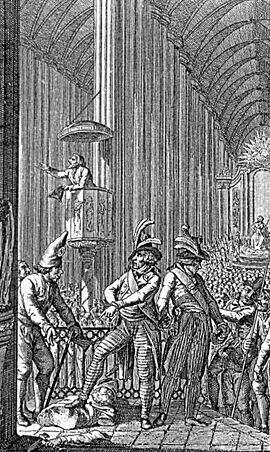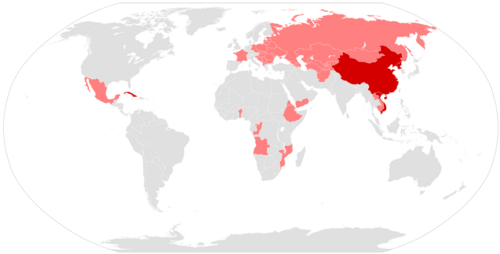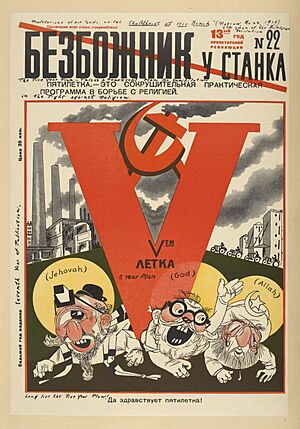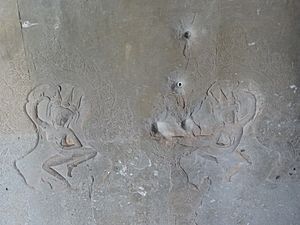State atheism facts for kids
State atheism means a government officially says there is no God or religion. It's like the opposite of a theocracy, where a government is run by religious leaders. Sometimes, state atheism means the government tries to make people less religious. This can involve stopping religious groups from having power or influence in public life. In some cases, governments even replace religious traditions with non-religious ones. When a government promotes atheism, it's not seen as neutral about religion.
Many communist states, starting in 1917, had similar policies. The Soviet Union (1922–1991) was officially atheist for a long time. People who wanted to succeed in society often had to say they were atheists and avoid religious places. This was especially strong during the time of Joseph Stalin (1929–1953). Countries in Eastern Europe like Belarus, Bulgaria, Estonia, Latvia, Russia, and Ukraine also had strong state atheism policies. East Germany and Czechoslovakia had similar rules. The Soviet Union tried to stop public religious activities in many areas, including Central Asia. Today, China, North Korea, and Vietnam are officially atheist states.
Cuba was a state atheist country until 2019. Then, it changed its constitution to become a secular state, meaning the government is neutral about religion. Karl Marx, who created the ideas behind Marxism, thought religion was a way for people to cope with suffering. He believed that if society was fair, people wouldn't need religion for comfort. However, he didn't think religion needed to be completely removed. Later, Vladimir Lenin and others developed Marxism–Leninism. This idea explained religion and criticized it, leading to the promotion of atheism.
Even though Marx and Lenin were atheists, some communist groups are religious, like Christian communists. Some thinkers argue that Soviet communism, which actively stopped religion, was different from Marx's original ideas. They say that atheism's best political form is a secular state, not a state that forces atheism.
Contents
Soviet Union
State atheism, called gosateizm, was a main goal of the Soviet government. This policy lasted for 70 years and was new in world history. The Communist Party did many things to stop religion. They destroyed religious buildings, killed religious leaders, and filled schools and media with anti-religious messages. They wanted religion to disappear. The USSR was the first country to try to get rid of existing religions and stop new religious beliefs from forming.
After the Russian Civil War, the government used its power to stop religious beliefs. The Bolsheviks especially disliked the Russian Orthodox Church. They saw it as supporting the old rulers. During the forced collection of land, Orthodox priests told farmers that the Soviet government was evil. They encouraged people to fight against the government. The Soviet government punished many people, and while they targeted many religions, their actions against religion often depended on what the state wanted.
From the late 1920s to the late 1930s, groups like the League of Militant Atheists made fun of all religions. They bothered religious people. This group was set up by the Communist Party to promote atheism. They published newspapers, held talks, and organized events that mocked religion. Anti-religious messages were everywhere in Soviet life, from schools to media. They even created new non-religious ceremonies to replace old religious ones.
Within about a year of the revolution, the government took all church property. Between 1922 and 1926, 28 Russian Orthodox bishops and over 1,200 priests were killed. Many more were punished. Most religious schools were closed, and publishing religious books was banned. By 1940, the Russian Orthodox Church, which had 54,000 churches before World War I, had only 500 left. Overall, by 1940, 90% of churches, synagogues, and mosques from 1917 were closed, changed, or destroyed.
Since the Soviet era, countries like Russia, Armenia, Kazakhstan, Uzbekistan, Turkmenistan, Kyrgyzstan, Tajikistan, Belarus, Moldova, Georgia, Ukraine, and Lithuania have many different religions. Many Russians have returned to the Orthodox Church. By 2008, 72% of Russians said they were Orthodox, up from 31% in 1991. However, some experts say that people in these areas know very little about their religion or other faiths.
In 1928, Joseph Stalin created the Jewish Autonomous Oblast. This was meant to give Jewish people more freedom. Stalin also allowed Sharia law in Muslim-majority areas of the Soviet Union. The 1936 Soviet constitution protected people from religious discrimination.
Albania
In 1967, Enver Hoxha, the leader of Albania, said Albania was the "first atheist state in the world." The government claimed that religion was foreign to Albania. They used this idea to justify stopping religion and promoting state atheism. A law in August 1945 took most property from religious groups. Many religious leaders and believers were put on trial, and some were killed. All foreign Roman Catholic priests and nuns were sent out of the country in 1946.
Religious groups with leaders outside Albania, like the Jesuits, were told to stop their activities. Religious schools were banned because education became only for the state. Religious groups were not allowed to own land or run charities and hospitals.
Hoxha wanted to destroy all organized religion in Albania. Between 1945 and 1953, the number of priests dropped a lot. The number of Roman Catholic churches went from 253 to 100. Catholics were often called fascists.
The fight against religion was strongest in the 1960s. In February 1967, Albania started a campaign to remove all religious life. By the end of 1967, all churches, mosques, and other religious buildings were closed. Many were turned into warehouses, gyms, or workshops. By May 1967, religious groups had to give up all 2,169 religious buildings. Many became cultural centers for young people. A magazine reported that young people had created "the first atheist nation in the world."
Religious leaders were publicly shamed. Their special clothes were taken and disrespected. Over 200 religious leaders were put in prison. Others were forced to work in factories or farms. Some were killed or starved. A Franciscan monastery was set on fire, killing four old monks.
Article 37 of Albania's 1976 Constitution said, "The state recognizes no religion, and supports atheistic propaganda." The 1977 law gave prison sentences of three to ten years for "religious propaganda." This meant people caught with Bibles, Qurans, or other religious items faced long prison terms. A new rule made people change their names if they sounded too religious. Towns with religious names also had to be renamed. Hoxha's harsh campaign stopped public worship. But some Albanians secretly practiced their faith, risking severe punishment.
Parents were afraid to teach their faith to their children. Officials tried to catch Christians and Muslims during religious fasts. They gave out forbidden foods in schools and workplaces. Those who refused the food were publicly shamed. Priests who held secret services were jailed. A Catholic priest, Shtjefen Kurti, was killed in 1972 for secretly baptizing a child.
This law was seen as breaking the United Nations Charter about religious freedom. Denmark protested Albania's actions at the United Nations in 1983 and 1984.
In 1990, the policy of state atheism was stopped. Albania's 1998 Constitution made the country a parliamentary republic. It set up personal and political rights, including protection against being forced into a religious belief. Albania is now a member of the Organisation of Islamic Cooperation. The 2011 census found that 58.79% of Albanians are Muslim, making it the largest religion. Christianity is practiced by 16.99%. The rest are non-religious or belong to other groups. Today, surveys show that religion plays a role in the lives of 39% of Albanians. Albania is one of the least religious countries in the world.
Cambodia
The Khmer Rouge government in Cambodia (1975–1979) actively persecuted Buddhists. Buddhist buildings and temples were destroyed. Many Buddhist monks and teachers were killed. One-third of the country's monasteries were destroyed, along with many holy texts. 25,000 Buddhist monks were killed by the government, which was officially atheist. The leader, Pol Pot, believed Buddhism was "decadent." He wanted to erase Buddhism's 1,500-year history in Cambodia.
Under the Khmer Rouge, all religious practices were banned. The Khmer Rouge stopped Islam, Christianity, and Buddhism. But their harshest campaign was against the Cham Muslim minority.
China
China has a policy of official state atheism. Article 36 of the Chinese constitution allows freedom of religion. But it only lets members of state-approved groups practice religions. The government promotes atheism. In April 2016, the leader, Xi Jinping, said that members of the Chinese Communist Party must be "strong Marxist atheists." In the same month, a government crew destroyed a church. They drove a bulldozer over two Christians who protested.
Traditionally, many Chinese people practiced Chinese folk religions, Confucianism, Taoism, and Buddhism. These religions were important in daily life. After the 1949 Chinese Revolution, the Chinese Communist Party took power. For a long time, the government believed religion would disappear. They saw it as a sign of old ways and foreign influence.
During the Cultural Revolution, student groups called Red Guards turned religious buildings into non-religious ones or destroyed them. But this changed in the late 1970s. The 1978 Constitution allowed freedom of religion with some limits. Since then, many Buddhist and Taoist temples destroyed in the Cultural Revolution have been rebuilt.
The Communist Party says that religious beliefs and being a party member are not compatible. However, the state is not allowed to force ordinary citizens to become atheists. China has five officially approved religious groups: the Buddhist Association, Taoist Association, Islamic Association, Three-Self Patriotic Movement (Protestant), and Chinese Patriotic Catholic Association. These groups have some protection but are controlled by the government. Unregistered religious groups face problems. The constitution allows "normal religious activities" as long as they don't cause disorder or harm.
Article 36 of the 1982 Constitution of China says: "Citizens of the People's Republic of China enjoy freedom of religious belief. No state organ, public organization or individual may compel citizens to believe in, or not to believe in, any religion; nor may they discriminate against citizens who believe in, or do not believe in, any religion. The state protects normal religious activities. No one may make use of religion to engage in activities that disrupt public order, impair the health of citizens or interfere with the educational system of the state. Religious bodies and religious affairs are not subject to any foreign domination."
Most people in China say they don't belong to an organized religion. However, hundreds of millions follow folk traditions and spiritual beliefs. These include honoring ancestors and feng shui. They also have informal ties to local temples and unofficial house churches. The U.S. State Department reports that in 2007:
- Buddhists: 8%.
- Taoists: Unknown percentage, as it's often practiced with Confucianism and Buddhism.
- Muslims: 1%, with over 20,000 Imams.
- Christians: Protestants at least 2%, Catholics about 1%.
Statistics for Buddhism and Taoism are different from Islam and Christianity. This is because traditional Chinese beliefs mix Confucianism, Buddhism, and Taoism. So, a person might not say they are only Buddhist or Taoist, even if they go to those places of worship. Some experts say that in 2002, 95% of Chinese people were religious in some way. This includes traditional practices like burning incense for gods or ancestors.
The U.S. State Department has called China a "country of particular concern" for religious freedom since 1999. Freedom House says Tibet and Xinjiang have strong repression of religion. This is due to concerns about groups wanting to separate from China. The UN Special Rapporteur on Freedom of Religion says China's actions against the Uighurs are a "major problem." The Chinese government says it has "ample" religious freedom.
Cuba
Until 1992, Cuba was officially an atheist state. In August 1960, several bishops signed a letter against communism. They said it was not compatible with Catholicism. Fidel Castro then gave a speech criticizing priests who served "great wealth." He attacked Spanish-born priests, saying there were "fascist priests in Cuba."
At first, the Cuban government was more accepting of religion. But after the Bay of Pigs Invasion, they started arresting many believers. They closed religious schools. Prisons were filled with religious leaders in the 1960s. In 1961, the government took over Catholic schools, including Castro's old Jesuit school. In 1965, they sent 200 priests out of the country.
In 1976, the Constitution of Cuba added a rule. It said the "socialist state...educates the people in, the scientific materialist concept of the universe." In 1992, after the dissolution of the Soviet Union, Cuba declared itself a secular state. Pope John Paul II visited Cuba in 1998. This helped improve relations between the US and Cuba. Pope Benedict XVI visited in 2012, and Pope Francis in 2015.
The Cuban government continued to act against religious groups. In 2015 alone, they ordered the closure or destruction of over 100 Pentecostal, Methodist, and Baptist churches. While the Cuban constitution now allows religious freedom, the law is still unclear about building new churches. This has allowed officials to stop new churches from being built. However, people can still hold services in their homes and in religious buildings built before the Cuban revolution. Despite problems building new churches, there has been a big increase in evangelical worship. Tens of thousands of Cubans worship freely across the island each week.
East Germany
Article 39 of the GDR constitution (1968) promised religious freedom. But the government's policy was to promote atheism. East Germany had strong efforts to make society less religious. The German Democratic Republic (GDR) made anti-religious rules and promoted atheism for decades. This led to the number of people with no religion growing from 7.6% in 1950 to 60% in 1986. In the 1950s, scientific atheism became official government policy. This happened when Soviet leaders were setting up a communist government. As of 2012, the area of former East Germany was the least religious region in the world.
North Korea
The North Korean constitution says religious freedom is allowed. However, North Korea's Juche ideology has been called "state-sanctioned atheism." Atheism is the government's official position. A 2018 CIA report said that free religious activities almost don't exist. There are government-sponsored groups to trick people. The U.S. Commission on International Religious Freedom says it's hard to know what's happening in North Korea. But reports say officials stop religious activities. They say the government creates and controls religious groups to limit real religious practice. In 2004, a human rights report said North Korea is one of the most controlling governments. It's hard to monitor because it's so isolated. After 1,500 churches were destroyed during Kim Il Sung's rule (1948–1994), three churches were built in Pyongyang. Foreigners who go to these churches say the services seem staged for them.
The North Korean government promotes the cult of personality of Kim Jong Il and Kim Il Sung. This is like a political religion. They also promote the Juche ideology. This idea is based on strong Korean nationalism. It tells people to "avoid spiritual respect for outside influences." This was seen as including religions that came from outside Korea.
Since 2001, the U.S. State Department has called North Korea a "country of particular concern" for religious freedom. A Catholic leader, Nicolas Cheong Jin-suk, said that "no priests survived persecution" in the late 1940s. He said 166 priests and religious people were killed or kidnapped. This included the Roman Catholic bishop of Pyongyang, Francis Hong Yong-ho. In November 2013, it was reported that 80 people were publicly executed for being religious. Some were killed for having Bibles.
There are five Christian churches in Pyongyang: three Protestant, one Eastern Orthodox, and one Catholic. President Kim Il Sung and his mother often went to the Chilgol Church, a Protestant church. This church can be visited on tours. Christian groups are controlled by the Korean Christian Federation, a state-run religious organization. Chondoism is a religion from Korea. The Chondoist Chongu Party is part of the ruling group in North Korea. But the number of Chondoists is unknown.
Mongolia
The Mongolian People's Revolutionary Party (MPRP) promoted atheism until the 1960s. In the Mongolian People's Republic, after Japanese troops invaded in 1936, the Soviet Union sent its troops there in 1937. They started attacking the Buddhist religion. At the same time, a purge like Stalin's happened in the People's Revolutionary Party and the Mongolian army. The Mongolian leader, Khorloogiin Choibalsan, followed Joseph Stalin. He copied many of Stalin's policies. This purge almost completely got rid of Tibetan Buddhism. It is estimated that 30,000 to 35,000 people died.
Vietnam
Officially, the Socialist Republic of Vietnam is an atheist state. This is declared by its communist government. Article 24 of Vietnam's constitution recognizes religious freedom.
Non-communist states
Revolutionary Mexico
Articles 3, 5, 24, 27, and 130 of the Mexican Constitution of 1917 had rules against the church. They limited religious freedoms. These rules were not often used until President Plutarco Elías Calles took office in 1924. He wanted to make the church and state completely separate. Calles' Mexico has been called an atheist state. His plan aimed to get rid of religious practices in Mexico in the 20th century.
Foreign religious leaders were sent away, and church properties were taken by the government. Article 27 stopped churches from getting new property. It also stopped religious groups and leaders from running primary schools. The 1917 Constitution also banned religious orders (Article 5). It banned religious activities outside church buildings, which became government property. It also said the government would watch over religious activities (Article 24).
On June 14, 1926, President Calles made a law against the church, known as the Calles Law. His actions against Catholics included banning religious orders. He took away the Church's property rights. He also took away civil rights from religious leaders, like the right to a jury trial and the right to vote. Catholics disliked Calles even more because he openly spoke against Catholicism.
Because these anti-church laws were strictly enforced, people in strong Catholic states started to oppose him. This led to the Cristero War from 1926 to 1929. Both sides committed terrible acts. Some Cristeros used violent tactics, like torturing and killing public school teachers. The Mexican government punished religious leaders. They killed suspected Cristeros and their supporters. They often took revenge on innocent people.
A peace agreement was made with help from the U.S. Ambassador. However, Calles did not follow the agreement. He had about 500 Cristero leaders and 5,000 other Cristeros shot. This often happened in their homes in front of their families. After the supposed peace, Calles insisted that the state control all education. He stopped Catholic education and brought in socialist education. He said, "We must enter and take possession of the mind of childhood, the mind of youth." Persecution continued as Calles stayed in power. It didn't stop until 1940, when President Manuel Ávila Camacho took office. Attempts to stop religious education became stronger in 1934. An amendment to Article 3 of the Mexican Constitution tried to get rid of religion. It demanded "socialist education," which would "combat fanaticism and prejudices." It aimed to "build in the youth a rational and exact concept of the universe and of social life." In 1946, the socialist education rules were removed. New laws promoted non-religious education. Between 1926 and 1934, at least 40 priests were killed. Before the war, there were 4,500 priests. In 1934, only 334 priests were allowed by the government to serve 15 million people. The rest were killed, sent away, or couldn't get licenses. In 1935, 17 states had no registered priests.
Revolutionary France

The French Revolution first attacked corruption in the Church and the wealth of high-ranking clergy. Many Christians agreed with this, as the Church had a lot of power before the revolution. During a two-year period called the Reign of Terror, actions against the clergy became very violent. The new revolutionary government stopped the Church, ended the Catholic monarchy, and took Church property. They sent 30,000 priests away and killed hundreds more. In October 1793, the Christian calendar was replaced with one based on the date of the Revolution. Festivals of Liberty, Reason, and the Supreme Being were planned. New forms of non-religious belief appeared, including the deistic Cult of the Supreme Being and the atheistic Cult of Reason. The government briefly made people follow the Cult of the Supreme Being in April 1794.
Human rights
Governments that are against religion, including atheist states, have often gone against international human rights law. Article 18 of the Universal Declaration of Human Rights protects freedom of thought, conscience, and religion. In 1993, the UN's human rights committee said that Article 18 protects beliefs that involve God, beliefs that don't, and atheistic beliefs. It also protects the right not to have any religion or belief. The committee also said that the freedom to have a religion or belief means the freedom to choose one. This includes the right to change one's religion or to become atheist. Countries that signed this agreement are not allowed to use threats or punishments to force people to give up their beliefs or convert. Despite this, in 2009, minority religions were still being persecuted in many parts of the world.
Theodore Roosevelt spoke out against the Kishinev pogrom in 1903. This started a history of U.S. presidents commenting on religious freedom in other countries. In 1941, Franklin D. Roosevelt talked about Four Freedoms, including freedom of worship. These ideas became the basis for the Universal Declaration of Human Rights. Jimmy Carter asked Deng Xiaoping to improve religious freedom in China. Ronald Reagan told U.S. Embassy staff in Moscow to help Jewish people who were being bothered by Soviet authorities. Bill Clinton created the United States Commission on International Religious Freedom in 1998. Its goal was to use diplomacy to promote religious freedom in countries that stopped it. Countries like Albania had anti-religious policies and promoted atheism, which affected people's religious rights.
See also
- Anti-clericalism
- Antireligion
- Civil religion
- History of Atheism
- Religious persecution
- Secularism
- Secularization
- State religion





